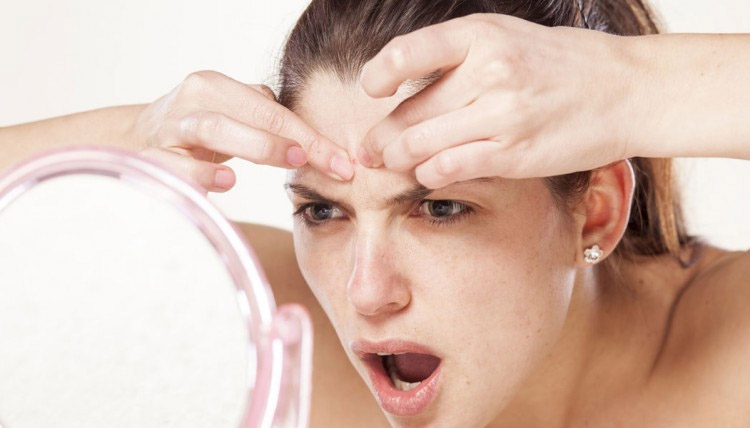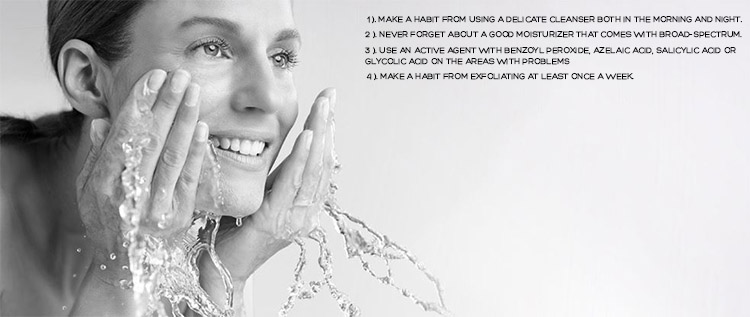
Even if acne is quite a common skin condition among teenagers, breakouts and serious skin disorders may happen to adults too and women seem to experience it a lot more. A report conducted by Dr. Bruce Hensel for NBC4 News revealed that “more than a quarter of clinical acne patients are women aged 25 to 60.”
Not only acne is a serious problem, but you may also worsen the symptoms by touching your skin all the time, trying to solve the problem by popping or squeezing the annoying pimples.
Unfortunately for you, when you do it, you’re anything but close to solving the acne problem. Additionally, you’re going to aggravate the acne and damage your skin’s integrity. Picking at your breakouts is going to cause severe scarring and hyperpigmentation so you’re going end up facing a bigger and more permanent problem than acne.
 Still on the fence about it? Dermatologist Dr. Shari Hicks-Graham of Downtown Dermatology in Columbus, Ohio, tries to make it all clear for all of us: “For women of color, an additional challenge relating to acne is the mark from the resolved pimple that can be visible far longer than an active pimple itself. ” He is determined to help us get the whole picture and gives more explanations: “It is critical to understand how best to manage our inflamed pimples from the start so that the marks fade as quickly as possible.”
Still on the fence about it? Dermatologist Dr. Shari Hicks-Graham of Downtown Dermatology in Columbus, Ohio, tries to make it all clear for all of us: “For women of color, an additional challenge relating to acne is the mark from the resolved pimple that can be visible far longer than an active pimple itself. ” He is determined to help us get the whole picture and gives more explanations: “It is critical to understand how best to manage our inflamed pimples from the start so that the marks fade as quickly as possible.”
Hold your horses if you’re just on the verge on starting popping those pimples and see what Dr. Hicks-Graham has to tell us about the risk you’re taking when you do it. After all, hyperpigmentation is a much serious problem than acne: “The number one reason that these acne lesions become deeper in color and even cause indentations in the skin that lead to scarring and texture irregularity is because of squeezing and picking,” told Dr. Hicks-Graham to Essence. He continues in the attempt of the real understanding of the bigger problem: “This physical manipulation of our acne—whether blackheads, whiteheads, red papules, nodules or cysts—causes trauma to the skin that often drives inflammation deeper into the skin. This inflammation causes more hyperpigmentation because melanocytes (the pigment-containing cells) flood the affected area as it works to heal itself. The deeper the inflammation, the darker the mark. The darker the mark, the longer it takes to fade away and resolve.”
Assuming that you get it already that preventing is always easier than treating, there’s still one question to answer: how do you keep acne scarring and hyperpigmentation under control? Well, the answer to that is quite easy: developing a proper skin care routine is fundamental.
Don’t just start a skin care routine without knowing a thing or two about skin care, though. Here’s Dr. Hicks-Graham’s piece of advice on the matter: “When you know that acne can be a problem, start with a consistent skincare regimen that is gentle and sustainable”. He also reminds us that “Beware of falling for anything that promises a quick fix. Avoid anything that stings or hurts your skin. Anything that causes extreme dryness of pimples can dry out surrounding skin and cause an entire zone of hyperpigmentation.”
Truth be told, we all react better when we see some practical rules so here’s Dr. Hicks-Graham’s take on the proper skincare routine:
- Make a habit from using a delicate cleanser both in the morning and night.
- Never forget about a good moisturizer that comes with broad-spectrum. 30SPF is pretty good most of the time. At night, use a gentle facial lotion for proper care.
Dr. Hicks-Graham is very clear about the skin’s needs: “Skin of color requires sun protection, too, so do not skimp out on the sunscreen.” He also highlights that “Most moisturizers for daily use have an SPF 30 formulation available. This will help old marks fade—no question.”
- Use an active agent with benzoyl peroxide, azelaic acid, salicylic acid or glycolic acid on the areas with problems. Keep in mind to always moisturize afterwards, so that you don’t dry out your skin. only apply a very thin layer to the skin any now and then, paying attention to your skin. you should check if it takes the formula and doesn’t get irritated.
The doctor has found what works the best in most situation: “I recommend using adapalene 0.1% OTC (Differin gel 0.1%) at bedtime every other night after cleansing and moisturizing.”
- When you’re dealing with a whitehead or a pimple that is already on the surface of the skin, Dr. Hicks-Graham recommends to apply a clean and warm washcloth right on the pimple for 1 minute or so. Try to apply some gentle pressure to the side of the pimple, but always use a cotton-tipped swab for removing the pus. Q-tips are always a good idea.
The doctor has a big advertisement on that: “Under no circumstances should you use your fingers or nails to squeeze or pick acne”.
- Make a habit from exfoliating at least once a week. If it’s too drying for your skin or your skin gets all red, you should do it only any now and then.

Even if Dr. Hicks-Graham is all about including each of these steps into your regular skin care routine, it’s not mandatory to follow them religiously. As skin reacts differently, it’s far more important to see how your skin reacts and to make adjustments as you go.
“If any agents above have caused problems in the past for you, avoid them and don’t try more than one agent at a time when you are starting a new routine,”, she points out that you should make the changes your skin may need. “Begin with one new active in the evening, then add one new active agent for morning, one to two weeks after that. This way, you will be able to tell what is working or not without abandoning the entire plan.”
More than anything else, you should be patient about the results and consistent about following a skin care routine. “Acne can be a normal part of life, and skin of color demands gentle action,” dr. Hicks-Graham says and she ends up with one fundamental principle: “It is our response to it that can change the course of how it affects our skin for the long term.”
Post originally published on www.essence.com
